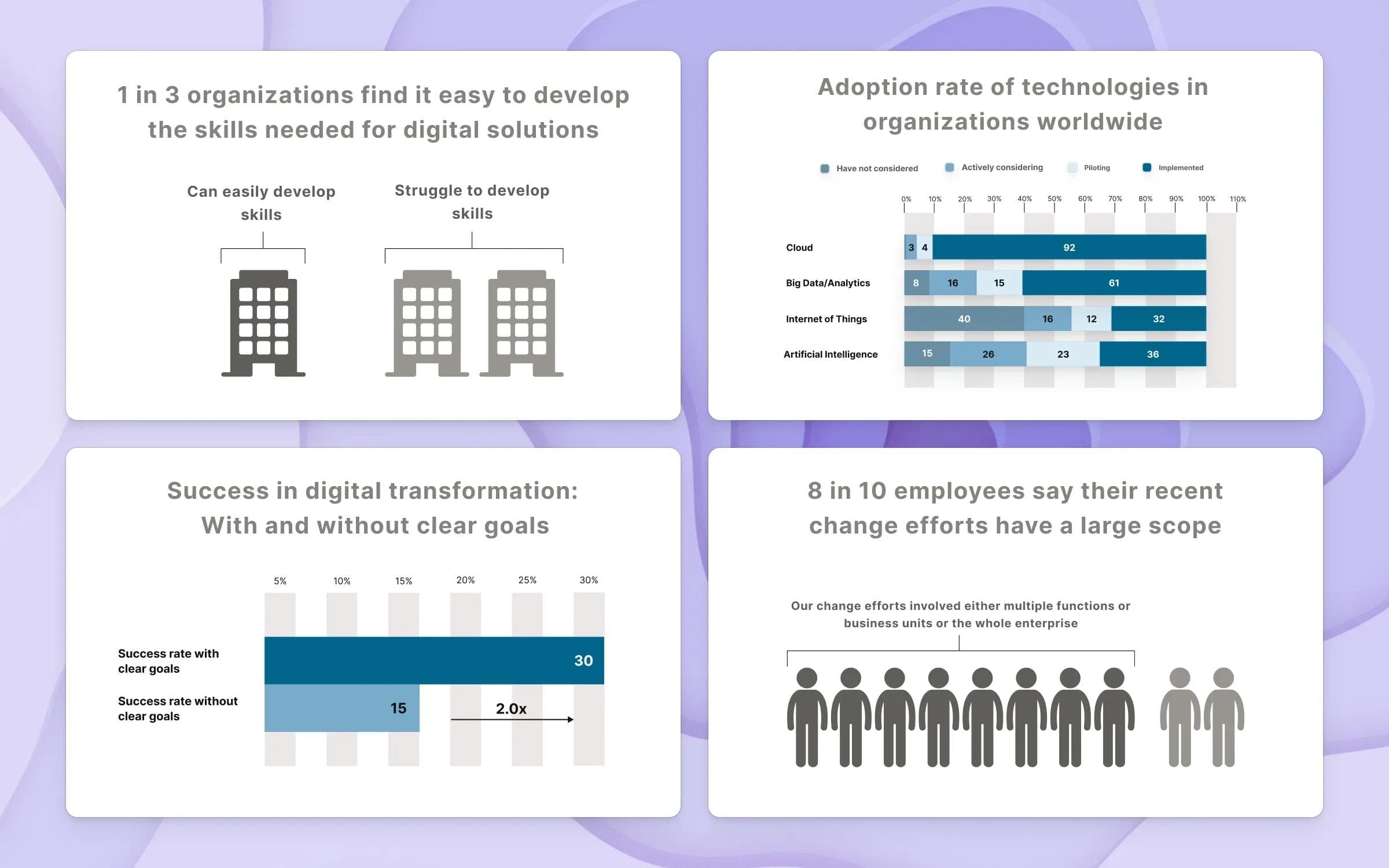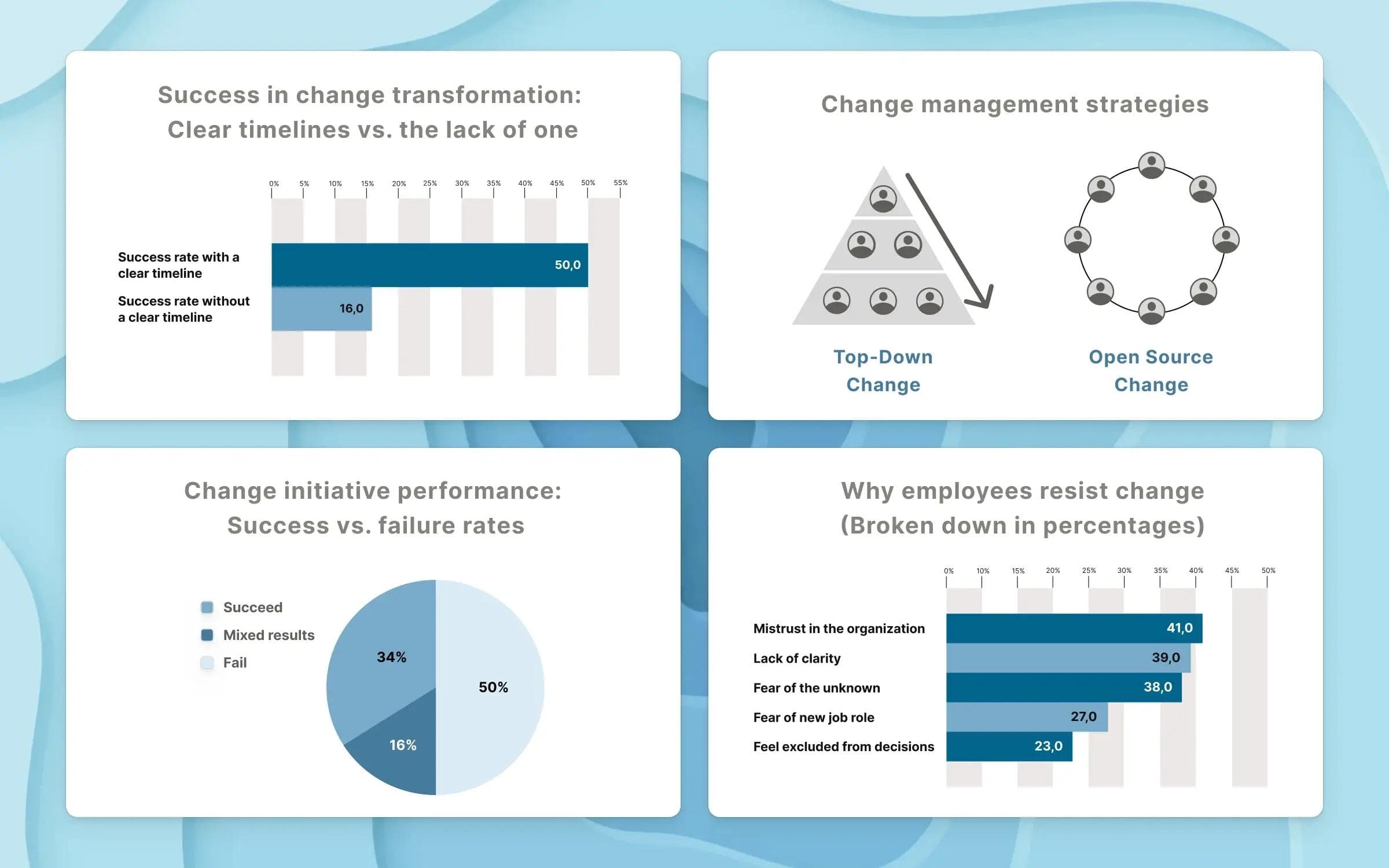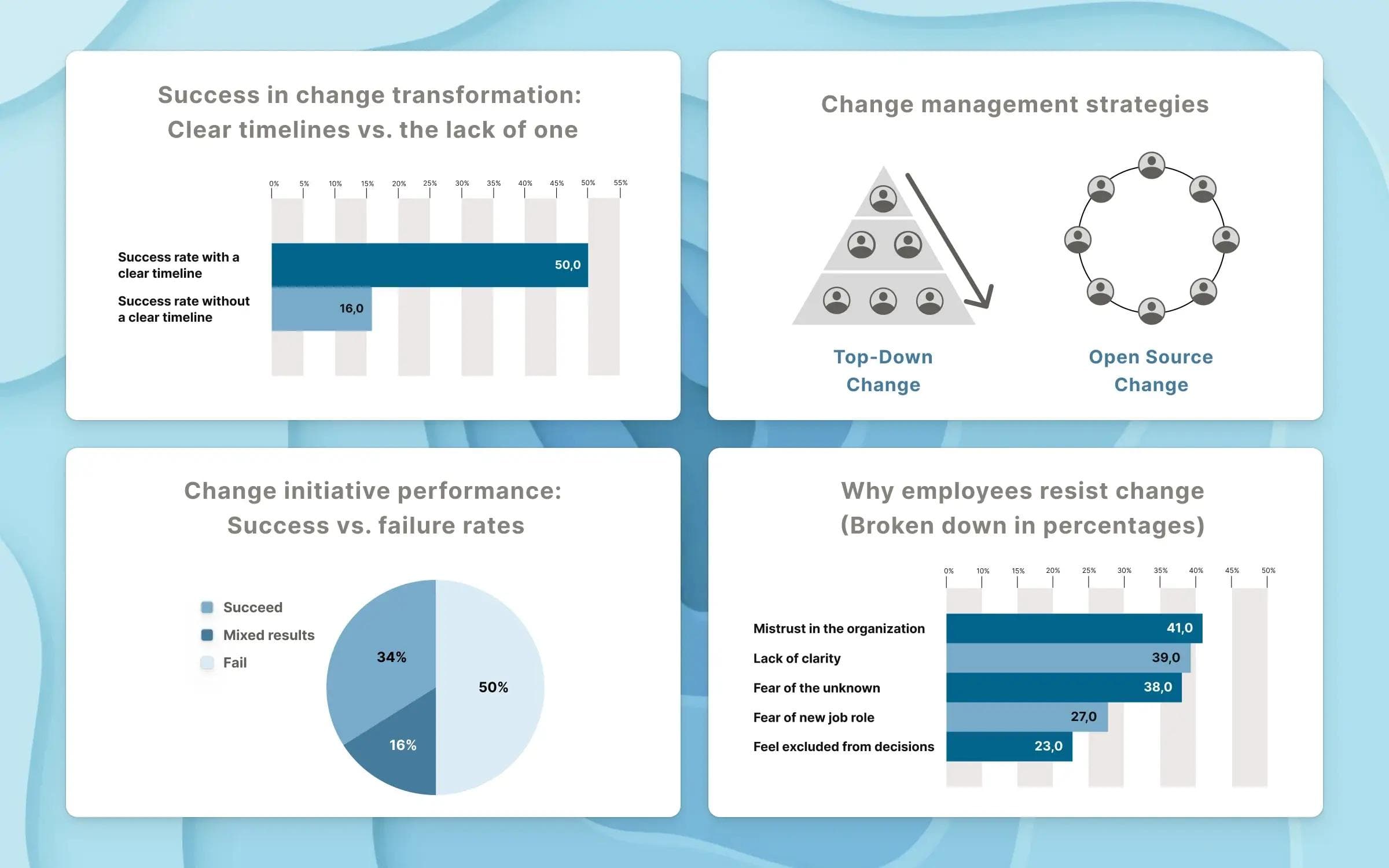AI has shown us how swiftly technology can rewrite the rules of business, turning yesterday’s innovations into today’s necessities.
The lesson?
Businesses must adapt or risk being left behind—they must embrace digital transformation (DX).
But digital transformation isn’t magic.
It’s a deliberate process of using technology to reinvent how businesses operate and deliver value.
This article dives into the what, why, and how of digital transformation, backed by 105+ statistics.
Read on as we explore:
- Why digital transformation matters now more than ever
- The key forces driving it forward
- Common pitfalls to avoid
- Proven best practices for success
Whether you’re leading the charge or catching up, this guide is your roadmap to a more innovative and resilient business.
Digital transformations statistics: Key insights
Digital transformation is more than a buzzword—it’s a fundamental shift in business operations and strategy:
- After all, 77% of companies are either using or exploring the use of AI in their businesses (National University, 2024)
Thus, the importance of digital transformation has steadily grown over the years.
- In 2018, 50% of respondents reported that their organization’s most recent change efforts focused on digital transformation (McKinsey & Company, 2018).
Six years later the urgency is even greater:
- An estimated 90% of organizations are now undergoing some form of digital transformation (McKinsey & Company, 2024).
The pressure to understand and skillfully use technology is also increasing.
- According to one MIT survey, 93% of workers across industries and geographies affirm that being digitally savvy is essential to performing well in their role (MITSloan, 2021)
This is in part due to the widespread adoption of new technologies.
- 92% of leaders worldwide reported their companies have adopted cloud technology on a small or large scale, making it the most widely adopted technology (Cionet & Nash Squared in Statista, 2023).
- Additionally, 7% are either considering implementing or actively piloting it (Cionet & Nash Squared in Statista, 2023).
- Big data/analytics ranked second, with 61% of companies implementing it on some scale (Cionet & Nash Squared in Statista, 2023).
- Of those that have not adopted big data 31% are considering or piloting its use (Cionet & Nash Squared in Statista, 2023).
- To add to that, 32% of companies are actively implementing Internet of Things (IoT) (Cionet & Nash Squared in Statista, 2023).
- And another 28% are either piloting or actively considering using IoT (Cionet & Nash Squared in Statista, 2023).
AI adoption is also advancing:
- In 2023 36% of companies worldwide implemented AI technologies (Cionet & Nash Squared in Statista, 2023).
- And an additional 49% either piloted or considered implementing AI technologies (Cionet & Nash Squared in Statista, 2023).
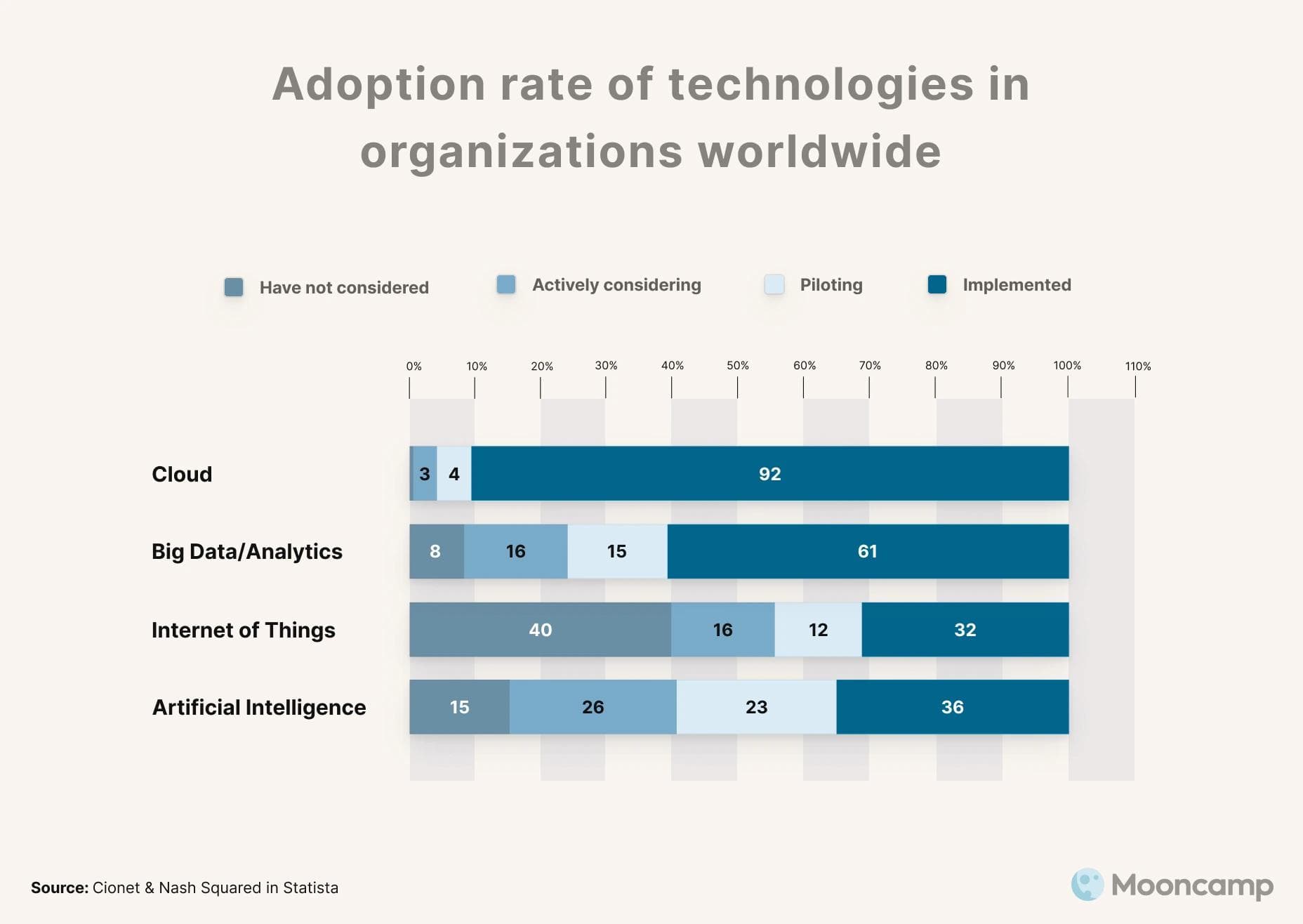
But what are the reasons for these digital advancements? Why do companies feel the need to digitally transform?
Why companies embrace digital transformation: Benefits and statistics
There are many reasons for companies to pursue digital transformations.
- However, the main reason businesses focus on digital transformation is to modernize their operations, replacing manual or outdated processes with technology-driven systems. According to McKinsey, 68% of respondents said this was their main reason for transforming (McKinsey & Company, 2018).
Many companies also use digital transformations to support environmental, social, and governance (ESG) strategies.
- In fact, 48% of 2,100 respondents identified ESG goals as a central priority for their technology teams in the next two years (KPMG, 2023).
Another reason for digital transformation is staying competitive.
Organizations often prioritize new technologies because they believe their competitors are already using them.
- For example, 45% of organizations are focusing on AI and machine learning because they believe top companies are already using these technologies (KPMG, 2023).
- And 52% of organizations are focusing on virtual and augmented reality, including the Metaverse, for the same reason (KPMG, 2023).
A 2019 study also suggests that digital transformation is largely driven by market pressures.
- For instance, 51% of organizations cited growth opportunities, while 41% pointed to competition as a key motivator for their transformation efforts (Prophet, 2019).
- Additionally, 38% of organizations are motivated by new regulations, like GDPR, to adapt and transform (Prophet, 2019).
But digital transformation isn’t just a hype—it brings real benefits.
- On average, 63% of respondents saw improved performance thanks to their digital transformation efforts in the last two years (KPMG, 2023).
- And the majority of respondents in 2023 reported that technology investments improve profits or performance by over 10%, a significant increase from 2022’s improvement of just 2.5% (KPMG, 2023).
- Similarly, 56% of CEOs say digital improvements have led to increased revenue (Gartner, 2017)
Investing in specific technologies can also unlock these benefits.
- For one, 29% of businesses report at least an 11% boost in performance or profits from investing in data and analytics (KPMG, 2023).
- 27% of businesses see better performance or more profits from using cloud services and as-a-service tools (KPMG, 2023).
- And 26% of businesses achieve that boost in performance or profits by investing in AI and automation (KPMG, 2023).
In a different study, executives listed the following reasons as the top benefits of digital transformation:
- Improved operational efficiency (40%) (PTC, 2018),
- faster time to market (36%) (PTC, 2018),
- and the ability to meet customer expectations (35%) (PTC, 2018).
Digital transformation statistics: Failure rates and key insights
A successful digital transformation can improve performance, drive profits, and unlock new revenue streams.
However, not all transformation efforts achieve their goals.
- In 2021, only 35% of companies worldwide succeeded in achieving their digital transformation goals—a slight improvement from 30% in 2020 (BCG, 2021).
The failure rate of digital transformation can be even more pronounced in certain industries:
- In 2018, even digitally savvy sectors like high tech, media, and telecom achieved a success rate of just 26% (McKinsey & Company, 2018).
- However, more traditional industries such as oil and gas, automotive, infrastructure, and pharmaceuticals fared worse, with success rates ranging between 4% and 11% (McKinsey & Company, 2018).
Success rates in digital transformation also vary significantly by company size.
- Organizations with fewer than 100 employees are 2.7 times more likely to report success compared to those with over 50,000 employees (McKinsey & Company, 2018).
A particularly alarming insight is that when IT projects—critical components of digital transformation—fail, they can put a company’s survival at risk.
- According to a study by the University of Oxford and McKinsey, 17% of IT projects fail so badly that they can threaten the survival of a company (McKinsey & Company, 2012).
This emphasizes the importance of well-executed digital transformation to maintain and grow a business.
So how can organizations steer clear of digital transformation failures?
For one, by understanding the common traps.
Statistics on common pitfalls in digital transformation
Digital transformation is a big focus for many companies.
- 61% of top executives say digital transformation is a top priority, but making it work isn’t always easy (West Monroe, 2023).
Issues like competing goals, skill gaps, and poor data make it difficult to achieve.
- For example, 24% of IT leaders say the need to meet ESG goals is one of the main reasons digital transformation efforts fail (Veeam in Statista, 2023).
- Adapting to shifting customer need is also challenging, as reported by 20% of IT leaders during digital transformation (Veeam in Statista, 2023).
- When it comes to skill gaps, 38% of organizations say that a lack of digital skills is limiting the success of their transformation efforts (HBR, 2017).
- Similarly, 36% of leaders worry their workforce lacks the skills needed to support digital transformation (KPMG, 2023).
- 27% of senior leaders also identify a lack of technical expertise as a major roadblock to achieving transformation goals (TEKsystems, 2024).
- And only 1 in 3 organizations find it easy to develop the skills needed for piloting and rapid prototyping of digital solutions (McKinsey & Company, 2018).
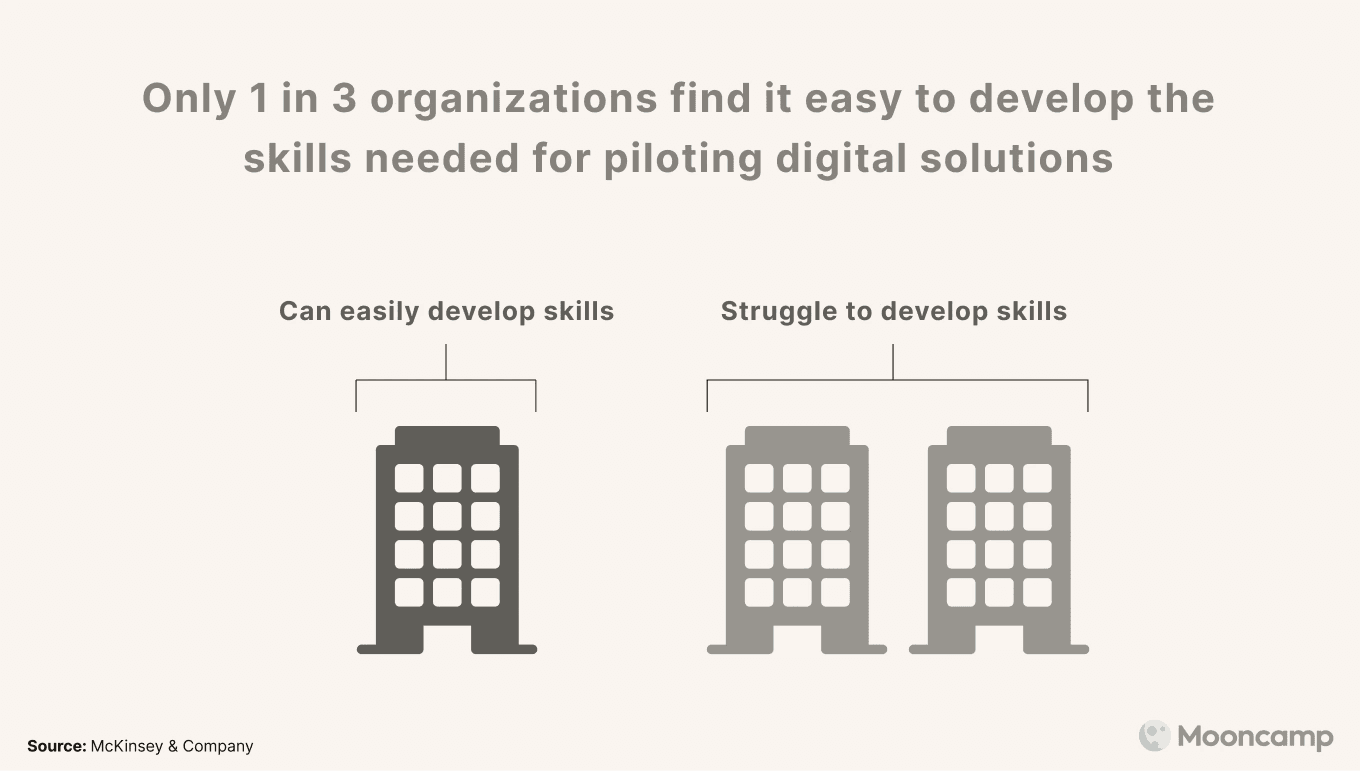
- Another study shows that 22% of IT leaders cite skill shortages as a key barrier to adopting new technologies (Veeam in Statista, 2023).
Poor data management is another common pitfall.
- Despite being vital to digital transformation, fewer than 50% of corporate strategies identify data and analytics as critical to delivering enterprise value (Gartner, 2019).
Many companies also struggle to manage sensitive data.
- In one study, 21% out of 783 respondents said the sensitive nature of data in digital business creates significant obstacles (HBR, 2017).
- Additionally, 24% of IT leaders identify cyber threats as a major challenge in digital transformation efforts, underscoring data security challenges (Veeam in Statista, 2023).
To add to that, new technologies and data processing often require new regulations, which can create challenges for businesses:
- In fact, 20% of 1,200 IT leaders said that navigating and implementing these regulations is a major hurdle for digital transformation (Veeam in Statista, 2023).
One has to remember that digital transformations are very complex.
They often involve big changes that affect many parts of a company:
- 75% of organizations undergoing digital transformation report involving multiple business units, compared to 64% for traditional transformations (McKinsey & Company, 2018).
- Additionally, 8 out of 10 respondents say their recent changes affected multiple departments or the entire organization (McKinsey & Company, 2018).
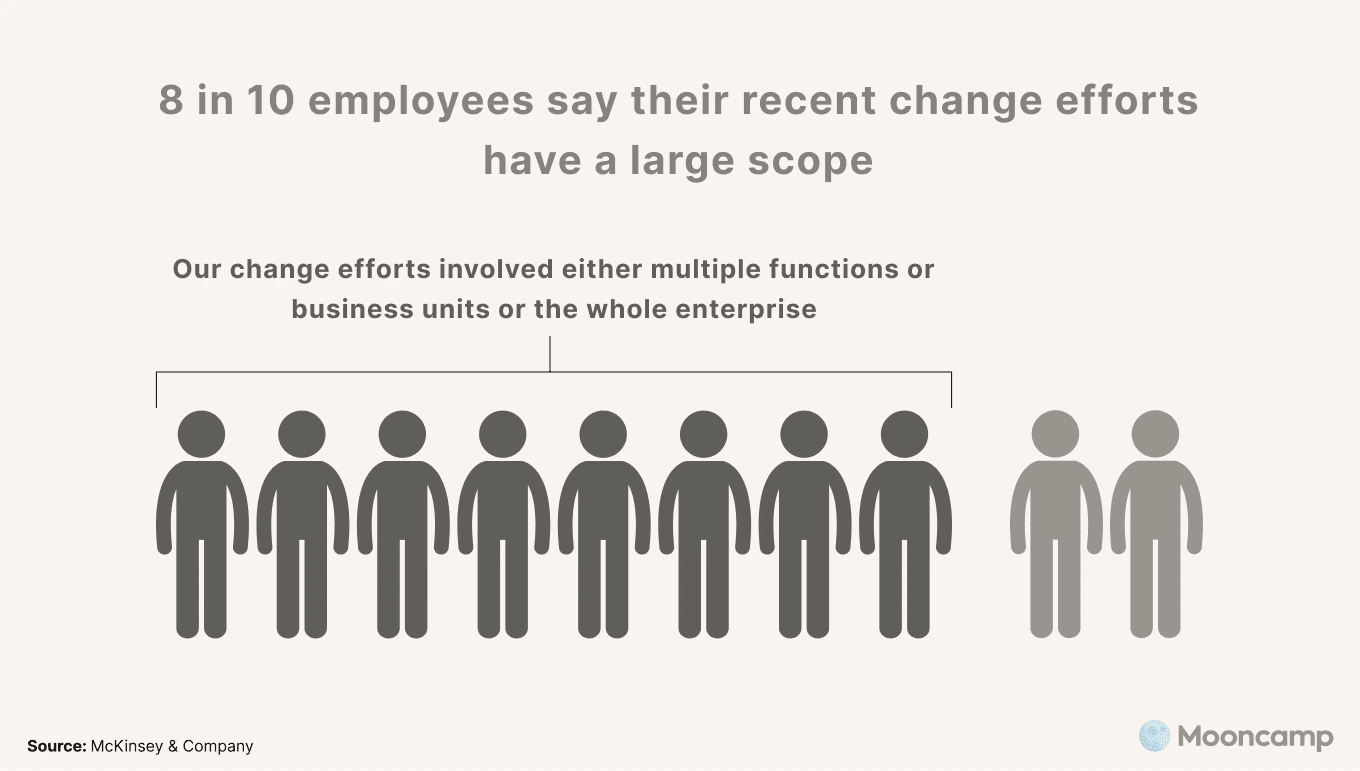
This complexity requires the company to reorganize teams and processes to fit new technologies and demands.
- However, 54% of respondents say this is a big challenge because digital work relies on teamwork, but many companies still work in separate "silos," which makes collaboration difficult (HBR, 2017).
This inability to adapt can seriously hinder digital transformation.
If the environment isn’t supportive, it creates major challenges for companies trying to make changes.
- 52% of respondents in an HBR study back this sentiment, stating that resistance to change is a key barrier to digital transformation (HBR, 2017).
- A survey of 1,299 IT leaders supports this idea, with 14% of respondents saying that resistance within their company prevented successful digital transformation (Veeam in Statista, 2023).
- A recent study also shows that 32% of leaders see complex work environments as a major obstacle to successful digital transformation (TEKsystems, 2024).
- Another study shows that 36% of organizations have a risk-averse culture, which holds them back and slows down progress in digital transformation (KPMG, 2023).
- In a similar finding, an HBR study showed that 36% of respondents said their organizations struggle to move away from outdated technology and processes (HBR, 2017).
- Furthermore, only 18% of executives believe their organization is strong and flexible enough to handle setbacks effectively (West Monroe, 2023).
Part of the problem is employees.
Many workers resist or have trouble adapting to new technologies, which slows down the transformation process.
- For example, 47% of executives believe less than half of their employees have embraced digital transformation (West Monroe, 2023).
- Similarly, 30% of executives say workforce mindset and culture issues hinder their digital transformation efforts (West Monroe, 2023)
But what exactly causes this inflexibility?
- A 2024 study revealed that 54% of employees feel unprepared to handle changes brought by new technologies. Their lack of readiness often causes resistance and mistakes during the transition process (KPMG, 2024).
This is likely due to a lack of transparency and support from organizational leadership.
- After all, Prophet reports that 28% of digital transformation initiatives are often owned or sponsored by CIOs, with 23% of CEOs increasingly playing a leadership role (Prophet, 2019).
- Yet, 20% of IT leaders say that unclear or unsupportive organizational leadership is a major reason digital transformation efforts fail (Veeam in Statista, 2023).
- And nearly half of organizations (46%) admit their technology teams lack the organization and oversight needed to effectively support transformation efforts (KPMG, 2023).
Even leaders admit they must better communicate the importance and function of new technologies.
- 69% of tech leaders say they need to do a better job explaining new technologies to their boards to get support for digital transformation (KPMG, 2023).
- If leaders fail to create a clear "change story"—a narrative that explains the transition process and its goals—the organization is 3.1 times less likely to succeed in its digital transformation (McKinsey & Company, 2018).
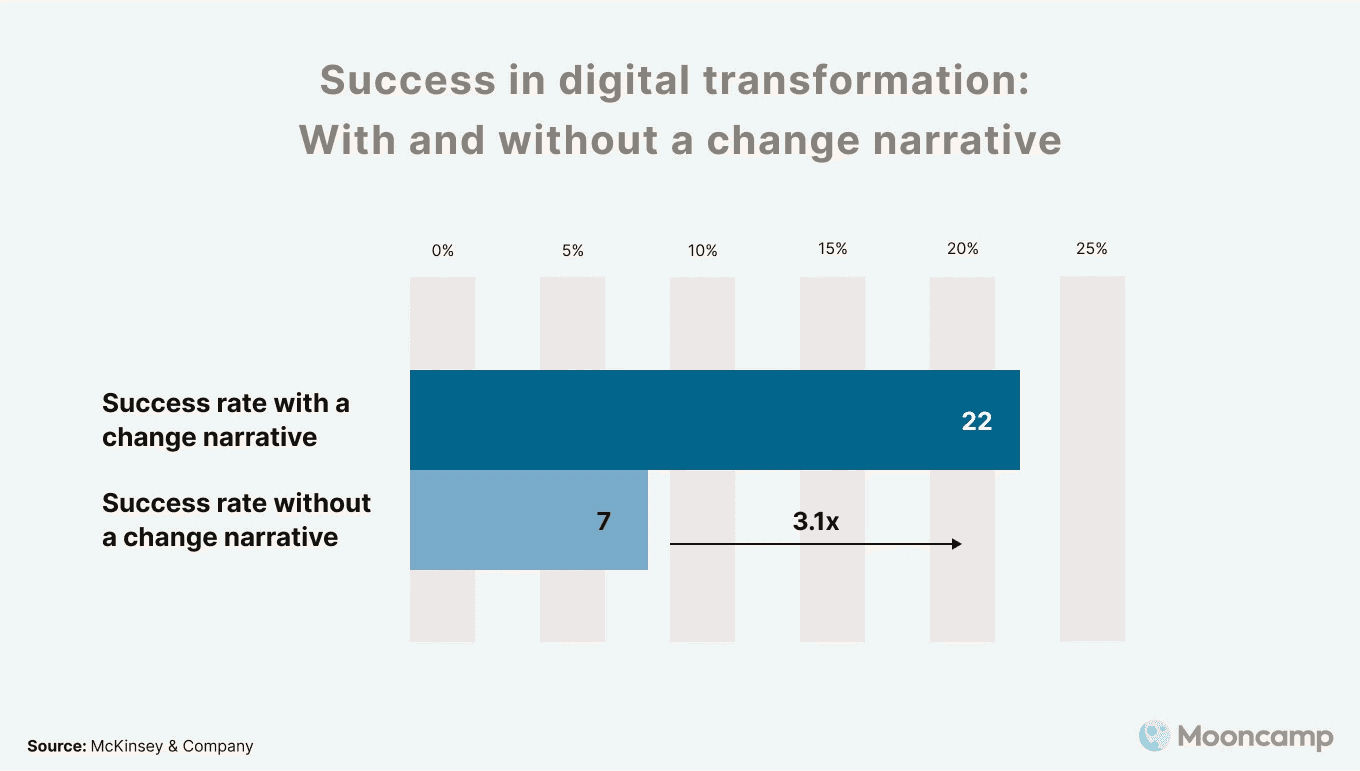
Another factor that can hinder digital transformation is not having the right tools.
- 8% of respondents in an HBR study say their company lacks the right technology, which hinders digital transformation efforts (HBR, 2017).
- And another study of 2,000 business and technology executives supports this, with 45% of executives believing their company doesn’t have the technology needed to successfully implement digital transformation (Global Digital IQ, 2015).
Lastly, the high cost of digital transformation can create setbacks, especially if a company lacks the necessary budget or resources to support the initiative.
- One study found that 26% of senior executives see high costs as a major obstacle to digital transformation (TEKsystems, 2024).
- Similarly, a survey by Veeam revealed that 22% of IT leaders view economic uncertainty as a significant challenge to implementing digital transformations (Veeam in Statista, 2023).
Let's recap what the top challenges are:
- Competing priorities: Conflicting business goals and a lack of focus on transformation can prevent organizations from aligning efforts, slowing progress.
- Skill gaps: Many employees and leaders lack the technical skills required to support and implement digital tools, hindering success.
- Resistance to change: Employees and teams often resist new processes and technologies, making it harder to adopt transformative solutions. Though this is often due to poor preparation and communication.
- Leadership challenges: Unclear or unsupportive leadership fails to provide the vision and guidance needed for successful transformation initiatives.
- Technological barriers: Outdated tools and a lack of access to modern technologies limit the ability to fully realize transformation goals.
- Cost and economic uncertainty: High implementation costs and financial instability discourage businesses from investing in digital transformation.
- Data and cybersecurity Issues: Poor integration of data analytics and growing cyber threats make it difficult for organizations to leverage data safely and effectively.
Digital transformation: Best practices backed by statistics
Now we know what can cause digital transformations to fail.
But what causes them to succeed?
The first step is setting a clear goal and plan for the transformation.
- Companies with clear targets for their organization's KPIs are twice as likely to succeed in their digital transformation efforts (McKinsey & Company, 2018).
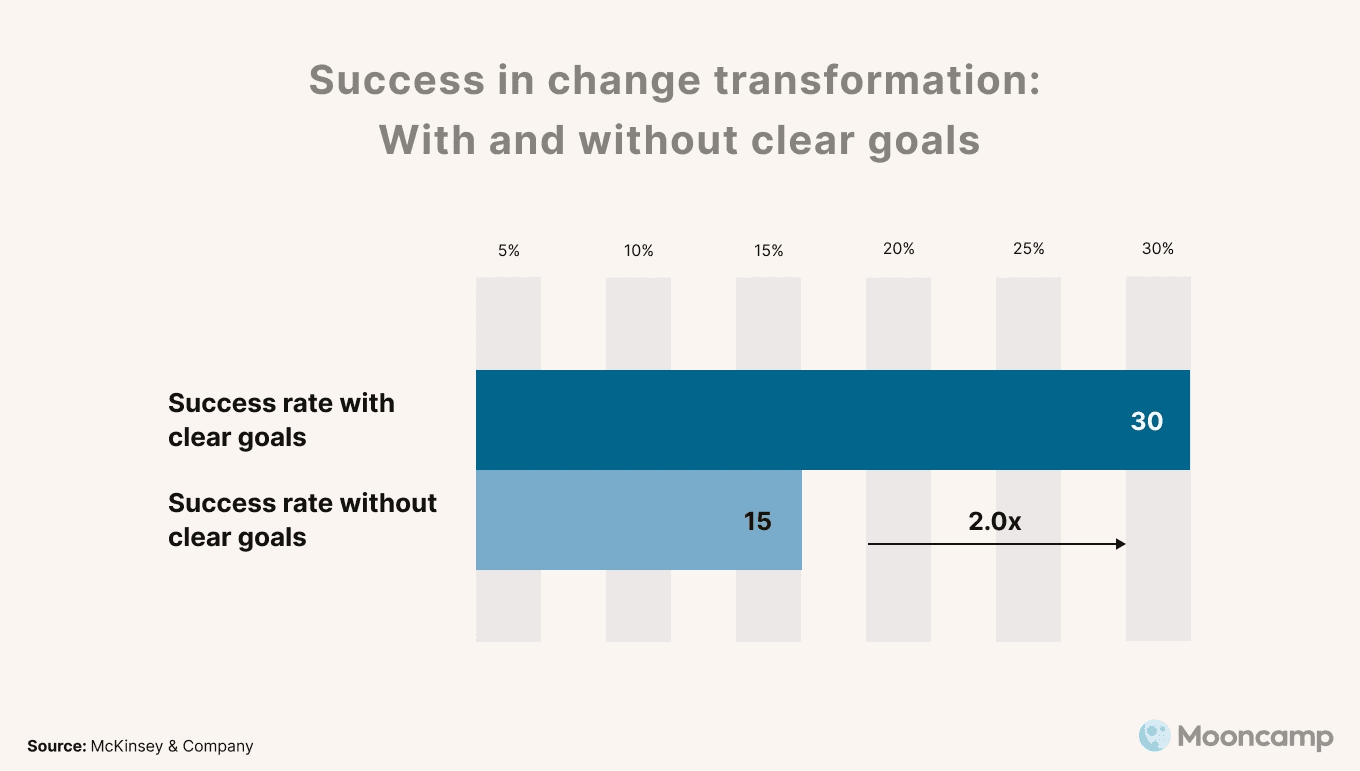
Clear targets help prioritize ideas and efforts.
- And digital transformation is 2.7 times more likely to succeed when organizations clearly prioritize ideas for digital solutions (McKinsey & Company, 2018).
But it’s not just about having clear goals—successful companies are also more likely to actively plan for change.
- Data reveals that top digital implementers are 3 times more likely to plan for the long-term success of changes from the outset compared to their counterparts (McKinsey & Company, 2018).
This difference becomes clear when comparing top-performing companies to laggards:
- 80% of top-performing companies proactively evaluate and plan for cybersecurity and privacy risks, compared to just 64% of laggards (Global Digital IQ, 2015).
Equally important, however, is effectively communicating this vision throughout the organization.
- Organizations that can clearly communicate the desired outcome before launching it are 3.5 times more likely to achieve a successful transformation (McKinsey & Company, 2018).
- Similarly, companies that clearly communicate a timeline for implementing digital initiatives are 1.8 times more likely to succeed (McKinsey & Company, 2018).
All of this helps create a transparent and resilient environment.
Another way of fostering transparency and flexibility is by tracking progress and demonstrating the value of the digital investments:
- Top-performing companies excel at showcasing the value of their digital investments, with 79% successfully doing so compared to 72% of lower-performing companies (Global Digital IQ, 2015).
- Embedding KPIs into long-term workflows increases the likelihood of successful digital transformations by 7 times (McKinsey & Company, 2018).
Furthermore, tracking progress also promotes alignment, which is another crucial factor in successful digital transformation.
- According to McKinsey, companies that redefine employees’ roles to align with digital transformation goals are 1.5 times more likely to succeed (McKinsey & Company, 2018).
Need help simplifying tracking, communication, and iteration for a successful digital transformation? A holistic framework can make it easier.
- Organizations that use a holistic framework to assess the value of new technology—considering not just their costs or customer benefits but also how it impacts operations and overall strategy—are 20% more likely to see meaningful results from their digital transformation efforts. (Deloitte Insights, 2024).
If you’re looking for a framework that breaks down big goals into clear, measurable steps and tracks progress, consider using OKRs.
📚 OKR (Objectives and Key Results) is an agile framework for setting and achieving strategic goals. It consists of three core elements:
- Objectives: What do I want to achieve?
- Key Results: How do I measure success?
- Initiatives: What actions will achieve the goal?
Typically, teams set 2–4 Objectives and 2–4 Key Results per Objective, mapped into specific initiatives. You can learn more in our OKR guide.
The OKR framework is a proven tool for driving change.
- Almost 60% of companies that use OKRs state that they use them as part of a change or transformation initiative (OKR Impact Report 2022).
Plus, it helps companies be more flexible.
- 67% of team members using OKRs believe their company can respond quickly to market changes. Without an OKR in place, only 50% feel this way (Haufe Talent, in German).
💡 Tip: To reduce manual work, save time, and avoid errors, try an OKR software. It helps you track progress, visualize goals, and keep everyone aligned—making digital transformation easier than ever.
How exactly can OKRs help? By reducing silos and fostering better communication, alignment, and progress tracking:
- Over 60% of companies using OKRs conduct regular check-ins, ensuring consistent communication and tracking progress (OKR Impact Report 2022).
- Additionally, 71% of OKR users hold a retrospective at the end of each OKR cycle, and 91% of them incorporate the findings from this session as they write OKRs and set KPIs for the next cycle (Haufe Talent, in German)
- And 98% of companies adopting OKRs report improved transparency and alignment (OKR Impact Report 2022).
📚 Want deeper insights into OKRs and their benefits? Then don’t miss out on the full OKR Impact Report 2022 for all the details.
Another thing that is important when creating a resilient environment is keeping employees involved in the process.
Being involved helps employees feel more prepared and connected to the company, reducing uncertainty and resistance to change:
- Thus, companies are 1.4 times more likely to succeed when employees contribute their own ideas about how digitization can support the business (McKinsey & Company, 2018).
- Organizations are also 3 times more likely to succeed with digital solutions if they
- train employees to use the new tools,
- set clear processes for handing off solutions to teams, and
- help employees master the tools immediately after implementation (McKinsey & Company, 2018).
However, even with the perfect plan, employees, and framework in place, success is not guaranteed.
To successfully transform your company digitally, you need the right leaders to guide the way.
- Unfortunately, less than one-third of organizations have a Chief Digital Officer, but those that do are 1.6 times more likely to succeed in their digital transformation efforts (McKinsey & Company, 2018).
But not just anyone can lead a digital transformation—leaders should have a solid understanding of the technologies being implemented.
- Nearly 70% of respondents reported that their organizations’ top teams changed during the transformation, often bringing in new leaders with expertise in digital technologies (McKinsey & Company, 2018).
- And 47% of digital transformations succeed when the business case is developed by experts with the necessary knowledge (McKinsey & Company, 2018).
- In contrast, success drops to just 18% when the business case is developed by others, such as the program management office (McKinsey & Company, 2018).
Additionally, leaders need to challenge outdated practices and inspire employees to do the same while fostering collaboration.
- Companies are 1.5 times more successful when senior leaders encourage questioning old habits (McKinsey & Company, 2018).
- And 1.6 times more successful when senior leaders encourage teamwork across departments (McKinsey & Company, 2018).
- Organizations are also 1.8 times more successful when key transformation leaders promote collaboration as well (McKinsey & Company, 2018).
As mentioned earlier, skill gaps pose a significant challenge in digital transformation.
The solution?
Hire strategically based on the company’s needs.
- Companies are almost 2 times as likely to succeed in digital transformations when they plan to hire around the specific skills needed across teams or the entire organization (McKinsey & Company, 2018).
- 27% of companies that adopt this approach report success, compared to fewer that do not (McKinsey & Company, 2018).
Companies also shouldn’t overlook new technologies—they’re what set successful digital transformations apart.
That’s why organizations that succeed are often those leveraging advanced technologies to their advantage.
- This makes sense, as adopting digital tools to improve information accessibility across the organization more than doubles the likelihood of a successful transformation (McKinsey & Company, 2018).
- Additionally, companies that adapt their technologies to meet employee needs can achieve up to 23% higher employee satisfaction and 22% higher profitability (MIT CISR, 2017).
In short, for the best chance at a successful digital transformation, you need:
- Clear goals and a strategy: Fixed goals and a strategy provide focus and direction, ensuring resources are effectively allocated and efforts align with business objectives.
- Communication and transparency: Strong communication helps everyone understand the purpose and steps of the transformation, while transparency builds trust and ensures accountability throughout the process.
- Involved employees and alignment: Engaging employees fosters collaboration and reduces resistance to change. Aligning roles with transformation goals ensures everyone is working toward the same vision.
- A holistic framework: A holistic framework, such as OKRs, ensures that technology investments are evaluated from multiple perspectives, maximizing their impact on business operations and outcomes.
- The right leaders: Strong leadership inspires change, challenges outdated practices, and promotes collaboration, creating a culture that supports transformation.
- Targeted hiring: Hiring and developing talent based on the specific needs of the transformation ensures teams have the expertise needed to implement changes effectively.
- Advanced technologies: Using advanced tools and technologies can simplify collaboration and innovation while aligning them with employee needs to ensure better adoption and satisfaction.
These are the pitfalls and best practices for achieving a successful digital transformation internally. However, for true success, digital transformation must also extend externally to customers.
Let’s explore the role of digital transformation in customer success.
Customer experience statistics in the age of digital transformation
Digital transformation plays a significant role in driving customer success.
In fact, one of the most common reasons organizations pursue digital transformation is the desire to improve customer satisfaction and deliver better experiences.
- For instance, 57% of businesses state they prioritize digital transformation to improve upselling and cross-selling opportunities (KPMG, 2023).
- 51% focus on digital transformation to better convert prospects into customers (KPMG, 2023).
Why is this important?
- Because digital transformation focused on customer experience can lead to a 20-30% increase in customer satisfaction and generate 20-50% economic gains (Mckinsey & Company, 2019)
Neglecting to advance digital processes can also cost companies customers.
In today’s digital age, companies that don’t adapt risk losing customers to more innovative competitors.
- 61% of consumers won’t return to a mobile site if it’s hard to access (Forbes, 2016).
- 40% of consumers will visit a competitor's site instead when they can’t access a company’s mobile site (Forbes, 2016)
But what exactly are customers expecting in this age of technology?
- In a study of 14,300 consumers, 73% expect improved personalization as a company’s technology advances (Salesforce, 2024).
- 74% also expect better customization the more data they provide (Salesforce, 2024).
Sadly, when it comes to digital transformations, there is often a rush to implement changes without conducting proper research or due diligence beforehand.
- As per one study: most organizations focus on improving customer interactions (54%) and upgrading infrastructure (45%) through digital transformations (Prophet, 2019).
- However, 41% invest in digital transformation without properly researching their customers' needs (Prophet, 2019).
Another challenge is customer hesitation around AI.
While digitalization brings many benefits, customers have concerns about the ethical use of AI:
- According to a Salesforce study, 74% of customers are worried about the unethical use of AI (Salesforce, 2024).
- Additionally, 80% believe it’s essential for a human to validate AI-generated outputs (Salesforce, 2024).
This uncertainty can lead to growing distrust among consumers.
With technologies like AI and data raising concerns, trust between companies and customers has become pivotal:
- 68% of customers say advances in AI make it more important for companies to be trustworthy (Salesforce, 2024).
- Additionally, 79% of customers are becoming increasingly protective of their personal data (Salesforce, 2024).
Companies need to build trust, and one way to achieve this is through clear communication:
- 71% of customers are more likely to trust a company with their personal data if its use is clearly explained (Salesforce, 2024).
In sum, digital transformation is not just about implementing new technologies—it’s about meeting customer expectations, enhancing trust, and delivering personalized experiences.
When executed thoughtfully, it drives both customer satisfaction and business success.
Conclusion
So here’s the verdict:
Digital transformation is no longer just an option; it’s a critical step for businesses to stay relevant and competitive.
After all, embracing digital transformation can bring big benefits like smoother operations, happier customers, and higher profits. But challenges such as resistance to change, poor data handling, and unclear plans can cause problems if not addressed properly.
To succeed, businesses need more than just new tools—they need clear goals, strong communication, and effective leadership.
Align your teams, invest in the right tools, and create a culture that embraces innovation.
Looking for tips to make digital transformation easier? Check out our blog for insights on strategy execution, goal setting, and effective frameworks to guide your journey.
Digital transformation statistics: FAQ
What is digital transformation?
Digital transformation is the process of using technology to change how businesses operate, deliver value, and meet customer expectations. It involves adopting digital tools to streamline processes, improve operational efficiency, and create new growth opportunities.
What are the top challenges of digital transformation?
- Resistance to change within organizations.
- Skill gaps in teams.
- High implementation costs.
- Issues with poor data management or cybersecurity threats.
What are the main benefits of digital transformation?
Digital transformation can lead to:
- Streamlined operations
- Enhanced customer satisfaction
- Higher revenue growth
- Faster time to market
- Improved decision-making through data analytics
What is the success rate of digital transformation
The success rate of digital transformation is low, with only 35% of companies worldwide achieving their goals in 2021 (BCG, 2021).
How can a company succeed in digital transformation?
Success depends on:
- Setting clear goals and KPIs
- Involving employees at every stage
- Addressing skill gaps with training or targeted hiring
- Using frameworks like OKRs to track progress
- Communicating a clear change story
Is digital transformation worth the investment?
Yes. Companies that invest in digital transformation report significant returns, such as:
- A 20-50% increase in economic gains when focusing on customer experience (Mckinsey & Company, 2019)
- Over 10% profit growth from technology investments (KPMG, 2023)
- Improved long-term resilience and competitiveness in the market
